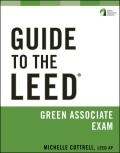
A guide to understanding the LEED Green Associate (GA) exam, authored by an expert that teaches LEED seminars to professionals through Sustainable Four. Ideal for anyone that is seeking the Green Associate credential, the book is a clearly organized study guide with sample quizzes throughout INDICE: Introduction. PART ONE: Ramping Up. Chapter One: Understanding theCredentialing Process. The Tiers of the Credentialing Process. The First Tier: LEED Green Associate. The Second Tier: LEED Accredited Professional (AP) with Specialty. The Third Tier: LEED AP Fellow. The Application Process. Apply! Register! Schedule! Why Earn the LEED Credentials? Chapter Two: Introduction tothe Concepts and Process of Sustainable Design. The Benefits of Green Buildings. The Triple Bottom Line. The Design and Construction Process. The Project Team Members. Conventional Projects vs. the Integrative Design Approach. Do Green Buildings Cost More? Chapter Three: Third Party Verification. USGBC and GBCI. Roles and Responsibilities . The Policies of USGBC and GBCI . Chapter Four:Understanding LEED. The LEED Rating Systems. LEED for New Construction and Major Renovation (LEED NC). LEED for Schools. LEED for Healthcare. LEED for Core& Shell (LEED C&S). LEED for Commercial Interiors (LEED CI). LEED for Retail.LEED for Existing Buildings: Operations and Maintenance (LEED EBOM). LEED forHomes and LEED for Neighborhood Development (LEED ND). The Categories of LEED. Prerequisites and Credits. Credit Weightings. Chapter Five: The LEED Certification Process Summarized. LEED Online. LEED for Existing Buildings. Minimum Program Requirements. The Certification Process for Projects. The Timeframes ofCertification Reviews. LEED for Homes and Neighborhood Development. Precertification. Recertification. PART TWO: Diving In: The Strategies & Technologies of LEED. Chapter Six: Sustainable Sites. Site Selection. Strategies. BrownfieldSites. Transportation. Strategies. Promote Alternative Methods of Transportation. LEED for Neighborhood Development. Site Design & Management. Strategies. Stormwater Management. Strategies. Chapter Seven: Water Efficiency. Indoor Water Use . Strategies. Outdoor Water Use for Irrigation. Strategies. Process Water. Strategies. Chapter Eight: Energy & Atmosphere. Commissioning. Minimum Energy Performance. Process Energy vs. Regulated Energy. Refrigerants. Existing Buildings. Strategies to Satisfy Energy & Atmosphere Prerequisites and Credits.Energy Demand. Energy Efficiency. Renewable Energy. Ongoing Energy Performance. Chapter Nine: Materials & Resources. Conducting Life-Cycle Assessments of Building Materials to Determine Selections. Calculating Green Building Productsfor LEED. Building Material Life-Cycle Impacts. Waste Management. Strategies to Reduce Waste. Chapter Ten: Indoor Environmental Quality. Indoor Air Quality. IAQ During Construction. IAQ During Operations. Strategies. Thermal Comfort.Strategies. Lighting. Strategies. Acoustics. Strategies. Chapter Eleven: Innovation in Design and Regional Priority. Innovation in Design. Regional Priority. PART THREE: Study Tips and Appendices. Chapter Twelve: Study Tips. Preparing for the LEED Green Associate Exam: Week Five. Practice Exam Approach . The Testing Center Environment. Exam Structure. When at the Testing Center. Exam Scoring. After the Exam. Appendices. A. Rating Systems Overview. B. Minimum Program Requirements (MPRs). C. LEED Certification Process . D. Main Category Summaries. E. Trade Offs and Synergies . F. Sample LEED NC Checklist/Scorecard. G.Sample Credit. H. Traditional Project Development vs. Integrative Project Development. I. Referenced Standards. J. Acronyms. K. Answers to Quiz Questions. L. Sample Flashcards. Credits.
- ISBN: 978-0-470-60829-6
- Editorial: John Wiley & Sons
- Encuadernacion: Rústica
- Páginas: 208
- Fecha Publicación: 13/10/2010
- Nº Volúmenes: 1
- Idioma: Inglés
